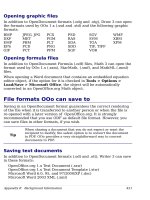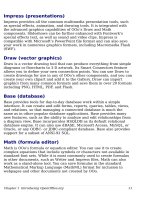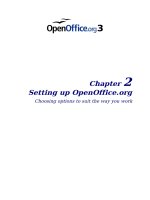Getting Started with Open Office .org 3 part 3 pot
Bạn đang xem bản rút gọn của tài liệu. Xem và tải ngay bản đầy đủ của tài liệu tại đây (4.77 MB, 10 trang )
• View contains commands for controlling the display of the
document such as Zoom and Web Layout.
• Insert contains commands for inserting elements into your
document such as Header, Footer, and Picture.
• Format contains commands, such as Styles and Formatting and
AutoFormat, for formatting the layout of your document.
• Table shows all commands to insert and edit a table in a text
document.
• Tools contains functions such as Spelling and Grammar,
Customize, and Options.
• Window contains commands for the display window.
• Help contains links to the Help file, What’s This?, and information
about the program.
Toolbars
OOo has several types of toolbars: docked, floating, and tear-off.
Docked toolbars can be moved to different locations or made to float,
and floating toolbars can be docked.
The top docked toolbar (default position) is called the
Standard
toolbar
. The Standard toolbar is consistent across the OpenOffice.org
applications.
The second toolbar across the top (default location) is the
Formatting
toolbar
. It is a context-sensitive bar that shows the relevant tools in
response to the cursor’s current position or selection. For example,
when the cursor is on a graphic, the Formatting bar provides tools for
formatting graphics; when the cursor is in text, the tools are for
formatting text.
Displaying or hiding toolbars
To display or hide toolbars, choose View > Toolbars, then click on the
name of a toolbar in the list. An active toolbar shows a checkmark
beside its name. Tear-off toolbars are not listed in the View menu.
Submenus and tear-off toolbars
Toolbar icons with a small triangle to the right will display
submenus
,
tear-off toolbars
, and other ways of selecting things, depending on the
icon.
Figure 2 shows a tear-off toolbar from the Drawing toolbar.
Chapter 1 Introducing OpenOffice.org 21
The tear-off toolbars can be floating or docked along an edge of the
screen or in one of the existing toolbar areas. To move a floating tear-
off toolbar, drag it by the title bar. See “Moving toolbars” below.
Figure 2: Example of a tear-off toolbar
Moving toolbars
To move a docked toolbar, place the mouse pointer over the toolbar
handle, hold down the left mouse button, drag the toolbar to the new
location, and then release the mouse button (Figure 3).
To move a floating toolbar, click on its title bar and drag it to a new
location (Figure 4).
Figure 3: Moving a docked toolbar
Figure 4: Moving a floating toolbar
22 Getting Started with OpenOffice.org 3
Click here and drag Toolbar tears off and
floats
Handle of docked toolbar
Title bar of floating toolbar
Floating toolbars
OOo includes several additional context-sensitive toolbars, whose
defaults appear as floating toolbars in response to the cursor’s current
position or selection. For example, when the cursor is in a table, a
floating
Table
toolbar appears, and when the cursor is in a numbered
or bullet list, the
Bullets and Numbering
toolbar appears. You can dock
these toolbars to the top, bottom, or side of the window, if you wish
(see “Moving toolbars” on page 22).
Docking/floating windows and toolbars
Toolbars and some windows, such as the Navigator and the Styles and
Formatting window, are dockable. You can move, re-size or dock them
to an edge.
To dock a window or toolbar, do one of
the following:
• Click on the title bar of the
floating window and drag it to
the side until you see the outline
of a box appear in the main
window, then release the window.
This method depends on your
system’s window manager
settings, so it may not work for
you.
• Hold down the
Control
key and
double-click on a vacant part of
the floating window to dock it in
its last position. If that does not
work, try double-clicking without
using the
Contro
l key.
To undock a window, hold down the
Control
key and double-click on a
vacant part of the docked window.
Note
The Styles and Formatting window can also be docked or
undocked by using
Control+double-click
on the gray area next
to the icons at the top of the window.
Chapter 1 Introducing OpenOffice.org 23
Figure 5: Docking a window
Customizing toolbars
You can customize toolbars in several ways, including choosing which
icons are visible and locking the position of a docked toolbar. You can
also add icons and create new toolbars, as described in Chapter 14.
To access a toolbar’s customization options, use the down-arrow at the
end of the toolbar or on its title bar (see Figure 6).
Figure 6: Customizing toolbars
To show or hide icons defined for the selected toolbar, choose Visible
Buttons from the drop-down menu. Visible icons have a checkmark
next to them. Click on icons to select or deselect them.
Right-click (context) menus
You can quickly access many menu functions by right-clicking on a
paragraph, graphics, or other object. A context menu will pop up.
Often the context menu is the fastest and easier way to reach a
function. If you’re not sure where in the menus or toolbars a function is
located, you can often find it by right-clicking.
Starting a new document
You can create a new, blank document in OOo in several ways.
When OOo is open but no document is open (for example if you close
all the open documents but leave the program running), a Welcome
screen is shown. Click one of the icons to open a new document of that
type, or click the Templates icon to start a new document using a
template.
You can also start a new document in one of the following ways. If a
document is already open in OOo, the new document opens in a new
window.
• Use File > New and choose the type of document.
• Use the arrow next to the New button on the main toolbar. From
the drop-down menu, select the type of document to be created.
• Press
Control+N
on the keyboard.
24 Getting Started with OpenOffice.org 3
Toolbar customization icons
• Use File > Wizards for some types of documents.
Opening an existing document
When no document is open, the Welcome screen provides an icon for
opening an existing document.
You can also open an existing document in one of the following ways. If
a document is already open in OOo, the second document opens in a
new window.
• Click File > Open.
• Click the Open button on the main toolbar.
• Press
Control+O
on the keyboard.
In each case, the Open dialog appears. Select the file you want, and
then click Open.
In the Open dialog, you can reduce the list of files by selecting the type
of file you are looking for. For example, if you choose Text documents
as the file type, you will only see documents Writer can open (including
.odt, .doc, .txt); if you choose Spreadsheets, you will see .ods, .xsl, and
other files that Calc opens.
You can also open an existing document that is in an OpenDocument
format by double-clicking on the file’s icon on the desktop or in a file
manager such as Windows Explorer.
If you have associated Microsoft Office file formats with OOo, you can
also open these files by double-clicking on them.
Note
Under Microsoft Windows you can use either the OOo Open and
Save As dialogs or the ones provided by Microsoft Windows.
See “Using the Open and Save As dialogs” on page 27.
Saving documents
To save a new document:
1) Choose File > Save.
2) When the Save As dialog appears, enter the file name and verify
the file type (if applicable).
To save an open document with the current file name, choose File >
Save. This will overwrite the last saved state of the file.
Chapter 1 Introducing OpenOffice.org 25
Password protection
To protect an entire document from being viewable without a
password, use the option on the Save As dialog to enter a password.
This option is only available for files saved in OpenDocument formats
or the older OpenOffice.org 1.x formats.
1) On the Save As dialog, select the checkbox beside Save with
password, and then click Save. You will receive a prompt:
2) Type the same password in the Password field and the Confirm
field, and then click OK. If the passwords match, the document is
saved password protected. If the passwords do not match, you
receive the prompt to enter the password again.
Note
Passwords must contain a minimum of 5 characters. Until you
have entered 5 characters, the OK button remains inactive.
OOo uses a very strong encryption mechanism which makes it almost
impossible to recover the contents of a document in case you lose the
password.
Saving a document automatically
You can choose to have OpenOffice.org save files for you automatically.
Automatic saving, like manual saving, overwrites the last saved state of
the file. To set up automatic file saving:
1) Choose Tools > Options > Load/Save > General.
2) Mark Save AutoRecovery information every, and set the time
interval.
Renaming and deleting files
You can rename or delete files within the OOo dialogs, just as you can
in your usual file manager. However, you cannot copy or paste files
within the dialogs.
26 Getting Started with OpenOffice.org 3
Using the Open and Save As dialogs
You can choose whether to use the OpenOffice.org Open and Save As
dialogs or the ones provided by your operating system. To view or
change which type of dialog OpenOffice.org uses:
1) Choose Tools > Options > OpenOffice.org > General.
2) Select the Use OpenOffice.org dialogs checkbox.
This section discusses the OpenOffice.org Open and Save As dialogs.
See Figure 7 for an example of the Save As dialog; the Open dialog is
similar.
The three buttons in the top right of the OOo Open and Save As dialogs
are, from left to right:
• Go Up One Level in the folder (directory) hierarchy. This is a
long-click button if you want to go up higher than just one level.
• Create New Folder.
• View Menu.
Figure 7: The OpenOffice.org Save As dialog, showing
some of the Save formats
Chapter 1 Introducing OpenOffice.org 27
For OpenOffice.org documents that have been saved with more than
one version, use the version drop-down to select which version you
wish to open in read-only mode. For Microsoft Office documents, only
the current version can be opened.
Use the File type field to specify the type of file to be opened or the
format of the file to be saved.
The Read-only checkbox opens the file for reading and printing only.
Consequently, most of the toolbars disappear, and most menu options
are disabled. An Edit File button is displayed on the Standard toolbar
to open the file for editing.
It is possible to open files from the Web using URLs.
Using the Navigator
The Navigator displays all objects contained in a document, collected
into categories. For example, in Writer it displays Headings, Tables,
Text frames, Notes, Graphics, Bookmarks, and other items (see
Figure 8.
Figure 8: The Navigator
In Calc it shows Sheets, Range Names, Database Ranges, Graphics,
Drawing Objects, and other items. In Impress and Draw it shows
Slides, Pictures, and other items. Click the + sign by any of the
categories to display the list of objects in that category.
28 Getting Started with OpenOffice.org 3
To open the Navigator, click its icon on the Standard toolbar, or
press
F5
, or choose Edit > Navigator on the main menu bar. You can
dock the Navigator to either side of the main OOo window or leave it
floating (see “Docking/floating windows and toolbars“ on page 23).
To hide the list of categories and show only the toolbars at the top,
click the List Box On/Off icon ( ). Click this icon again to show the
list box.
The Navigator provides several convenient ways to move around a
document and find items in it:
• When a category is showing the list of objects in it, double-click
on an object to jump directly to that object’s location in the
document. Objects are much easier to find if you have given them
names when creating them, instead of keeping OOo’s default
graphics1, graphics2, Table1, Table2, and so on—which may not
correspond to the position of the object in the document.
If you only want to see the content in a certain category, highlight
the category and click the Content View icon. Until you click the
icon again, only the objects of that category will be displayed.
• Click the (second icon from the left at the top of the
Navigator) to display the Navigation toolbar (Figure 9). Here you
can pick one of the categories and use the Previous and Next
icons to move from one item to the next. This is particularly
helpful for finding items like bookmarks and indexes, which can
be difficult to see. The names of the icons (shown in the tooltips)
change to match the selected category; for example, Next
Graphic or Next Bookmark.
Figure 9: Navigation toolbar
• To jump to a specific page in the document, type its page number
in the box at the top of the Navigator.
A bit of experimentation with the other icons will demonstrate their
functions. Some component-specific uses are described in the chapters
on Writer and the other components.
Chapter 1 Introducing OpenOffice.org 29
Closing a document
To close a document, click File > Close.
You can also close a document by clicking on the Close icon on the
document window. This button looks like the red X shown in Figure 10.
If more than one OOo window is open, each window looks like the
sample shown on the left in Figure 10. Closing this window leaves the
other OOo windows open.
If only one OOo window is open, it looks like the sample shown on the
right in Figure 10. Notice the small black X below the large red X.
Clicking the small X closes the document but leaves OOo open.
Clicking the large red X closes OOo completely.
Figure 10. Close icons
If the document has not been saved since the last change, a message
box is displayed. Choose whether to save or discard your changes.
• Save: The document is saved and then closed.
• Discard: The document is closed, and all modifications since the
last save are lost.
• Cancel: Nothing happens, and you return to the document.
Caution
Not saving your document could result in the loss of recently
made changes, or worse still, your entire file.
Closing OpenOffice.org
To close OOo completely, click File > Exit, or close the last open
document as described in “Closing a document” on page 30.
If all the documents have been saved, OOo closes immediately. If any
documents have been modified but not saved, a warning message
appears. Follow the procedure in “Closing a document” to save or
discard your changes.
30 Getting Started with OpenOffice.org 3









